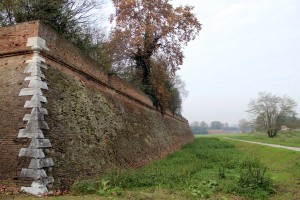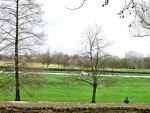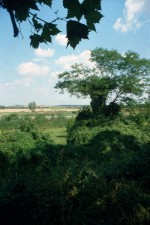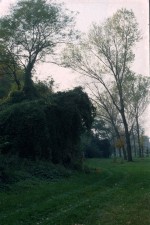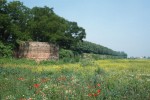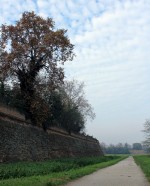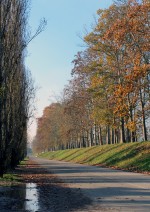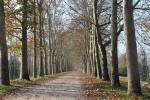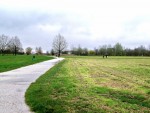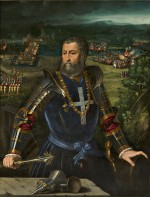The Walls
The mentioned city walls in the Poem embrace a modern Ferrara, the city that welcomes Ariosto once he leaves the locus amoenus of his maternal home in Reggio. In the approximately 9-kilometre layout, triangular-shaped fortifications are scattered, the main ones built around the 15th century.
The Este defense impresses Ariosto
Ariosto, who in 1484 arrives in Ferrara after leaving the delights of his maternal “Mauriziano”, finds himself in front of a fortified city with imposing walls that will leave such a deep impression on his imagination, appearing reflected in the cantos of the Furioso:
Lontan si vede una muraglia lunga
Che gira intorno , e gran paese serra;
e par che la sua altezza al ciel s’aggiunga,
e d’oro sia da l’alta cima a terra.
…a me par oro, poi che sì risplende.
(O. F. VI, 59)
Come fu appresso alle sì ricche mura,
che’l mondo altre non ha de la lor sorte,
lasciò la strada che per la pianura
ampla e diritta andava alle gran porte;
(O. F. VI, 60)
The layout designed by Biagio Rossetti is an example of a perfect fusion between the city and the defensive structure of the walls. He adapts the defensive structure to the needs of a new city, fitting it to the perimeter outlined by the existing borough structures: “...he could have applied a radial-centric, octagonal or star-shaped perimeter scheme, or even orthogonal. The shell would have prevailed over the inhabited area, the container over the content, military defence over community life. He refused, paying, once again, for his greatness as an urban planner and architect at the price of fame in the field of Renaissance treatises”. (Zevi 1960, p. 82). Ariosto himself is impressed by the strategic skill in the Este defensive system, praising the greatness of the Dukes, especially Ercole I and Alfonso I, who, demonstrating their concern for the city's security, invested intense efforts in the impressive fortification work.
E che sarebbe tal per studio e cura
Di che al sapere et al potere unita
La voglia avendo, d’argini e di mura
Avria sì ancor la sua città munita,
che contra tutto il mondo star sicura
potria, senza chiamar di fuori aita.
(O. F. XLIII, 1-6)
Enhancement
Thanks to the dedication and efforts of author Giorgio Bassani, restoration work on Ferrara’s city walls began in the 1970s, eventually leading to the entire city and its surroundings being added to UNESCO’s World Heritage List.
On 7 March 1979, a meeting and discussion focusing on The Este Walls and the ‘Green Addition’ was held in Ferrara. The event was promoted by the Ferrara chapter of Italia Nostra, a national environmental association that was, at the time, chaired by Bassani, and it included a speech and the publication of an article/manifesto, titled Ferrara and its Walls. In that text, Bassani openly expressed his hopes for future of the landmark and his vision of the city walls as an essential, unique part of the city of Ferrara, as well as a symbolic national heritage site that was to be restored and protected.
The initial perimeter
The rediscovered walls, those mentioned by the Poet, encompass and make room for the Delights, the leisure residences of the Este family, where scholars and poets from all over the peninsula would gather. The fortified complex, originally with a perimeter of 13 kilometres, follows an initial outline dating back to the first half of the 12th century according to the wishes of Guglielmo degli Adelardi. It embraced the area north of the Po, the Borgo Nuovo, which remained enclosed until the mid-14th century. The walls then appeared as long straight and crenellated curtains, interspersed with square towers. A significant expansion occurred under Nicolò II d'Este in 1385 when, in conjunction with the construction of Castel Vecchio, the walls were strengthened, extending along the Po. New interventions, due to the progressive drainage of the river in the southern area, led to further extension in that direction. Bartolino da Novara was entrusted with the fortification of the southern part in 1401, and to highlight the new defensive point, the construction of Castel Nuovo was ordered in 1428, the work of the architect Giovanni da Siena.
Subsequent interventions arose in response to the armed conflicts in which Ferrara would be involved in the following years. In particular, the war of 1482 with Venice led Ercole I d'Este to request the enhancement of the northern area in the year after, with a vast embankment filling an area from Santa Maria della Rosa to Borgoleoni.
Expansion projects
The conflict with Venice prompted the Duke to further expand the city walls, encompassing the delights and small villages beyond the Giovecca moat. The expansion works for the northern section were entrusted to Biagio Rossetti in 1493 as part of the project for the "Addizione Erculea" and continued until 1505, bringing significant innovative changes. This expansion came to represent, as highlighted by Zevi, one of the earliest examples of an Italian bastioned front. The use of earthworks was reintroduced, effective in dampening the range of enemy projectiles. The city walls were inclined to utilise the counterthrust of the earthwork, providing additional stability to the structure. Rows of, presumably, poplar trees contributed to making the bastion more robust, arranged in rows along the ramparts. Bastions, constructed along the layout, became positions for firearms. Particularly under Alfonso I, they took on the characteristic arrowhead shape, located south of the city, more effective in facing the violence of firearm attacks.
Quotes
‘I suppose that no one would ever guess that I'm speaking as a writer. It’s true that I've sung of the city walls of Ferrara in almost all my books, in prose and verse, but today I'm here first and foremost as the President of Italia Nostra, to indicate, by being here, the important role that the association places on the repair, restoration, and saving of the city walls of Ferrara. I am here not just to express my hope that the walls of my city will be saved, but to reinforce the fact that we believe they, the walls, are a symbolic asset. If we can save them, if we can restore them as they should be restored, an example will be set for other Italian cities, which are illustrious and important to varying degrees, that find themselves in the same situation. ...The Ferrara city walls belong to the old town of the city, or rather, within a certain limit, they are the heart of the city itself. ...Today...they make up part of the old town of an immense city that, in some way, extends out to the sea (Bruno Zevi was the one to say it, and I agree with him. ...they aren’t on the outskirts of the city, but rather within it, they are the city. ‘ [G. Bassani, Ferrara e le Sue Mura (Ferrara and its Walls), speech at The Este Walls and The ‘Green Addition’ a meeting and discussion promoted by the Ferrara chapter of Italia Nostra and held in Ferrara on 7 March 1979; published under the title ‘Ferrara and its Walls’, Bollettino di Italia Nostra, 20 (1979), n. 181-182, p.3s., later published in G. Bassani, L’Italia da Salvare. Scritti Civili e Battaglie Ambientali, ed. C. Spila, Einaudi, Turin 2005, p. 222s., and in the following expanded edition, Giorgio Bassani. Italia da Salvare. Gli Anni della Presidenza di Italia Nostra (1965-1980), ed. D. Cola and C. Spila, Feltrinelli, Milan 2018, p. 241 s.]
Bibliography
- Girolamo Baruffaldi, La Vita di Lodovico Ariosto, Bianchi e Negri, Ferrara 1807
- Gianna Pazzi, Ferrara antica e Ferrara d'oggi (1000-1927), Lunghini & Bianchini, Firenze 1929
- Renzo Renzi (a cura di), Ferrara, il Po, la Cattedrale, la Corte dalle origini al 1598, edizioni Alfa, Bologna 1969
- Bruno Zevi, Saper vedere l'urbanistica: Ferrara di Biagio Rossetti, la prima città moderna europea, Einaudi, Torino 1971
- Antonio Frizzi, Memorie per la storia di Ferrara, Francesco Pomatelli, Ferrara 1971
- Raffaele Belvederi, Virgilio Ferrari, Arturo Malagù, Ferrara e l'Ariosto. La Ferrariae Decus nel V centenario della nascita del poeta, SATE, Ferrara 1974
- Ludovico Ariosto, Cesare Segre, Orlando furioso, I Meridiani Mondadori, Milano 1976
- Paolo Ravenna, Le mura di Ferrara. Immagini e storia, Panini, Modena 1985
- Laura Carlotti e Classe IIIB (a cura di), A me piace habitar la mia contrada: passeggiate letterarie per le vie di Ferrara alla ricerca di Ludovico Ariosto, Quaderni del Liceo Classico "L. Ariosto", Ferrara 2003
- Giorgio Bassani, Cristiano Spila, Dafne Cola, Italia da salvare. Gli anni della Presidenza di Italia Nostra (1965-1980) , Feltrinelli, Milano 2018
- Romeo Farinella, Salvaguardia e contemporaneità: riflessioni su di un difficile rapporto a partire da Ferrara in Giorgio Bassani ambientalista. Giornata di studi. Roma, Biblioteca nazionale centrale, 27 ottobre 2006, cur. C. Spila, G. Zagra, Quaderni della Biblioteca nazionale centrale di Roma, (12) 2007, p. 41s.
- Barbara Pizzo, Ferrara per gli occhi di Bassani. Vedute entro le mura e oltre in Giorgio Bassani ambientalista. Giornata di studi. Roma, Biblioteca nazionale centrale, 27 ottobre 2006, cur. C. Spila, G. Zagra, Quaderni della Biblioteca nazionale centrale di Roma, (12) 2007, p. 65s.
Sitography
- http://www.ferraraterraeacqua.it/it/scopri-il-territorio/itinerari-e-visite/cicloturismo-mountain-bike/le-mura-di-ferrara
- http://www.liceoariosto.it/archeologia/materiale/II.5%20La%20Porta%20degli%20Angeli%20sulle%20mura%20di%20Ferrara.pdf
- http://www.an-patrimoine.org/IMG/pdf/ferrara_unesco_storia_scafuri.pdf
- http://www.comune.fe.it/attach/amodonesi/docs/presentazione_lavori_mura_estensi_9ott12.pdf
- https://www.italianostra.org/chi-siamo/i-presidenti/giorgio-bassani/
Archival Sources
- ‘What would Italy be like without the generous efforts of Italia Nostra and Giorgio Bassani, who was President of that meritorious association from 1965 to 1980? Certainly crumbling more than it is today’, wrote Fulco Pratesi in the text of the back cover of Italia da Salvare (‘Italy to be Saved’, by G. Bassani, published by Einaudi in 2005) Bassani also wrote of Italia Nostra’s mission: ‘cultural and natural heritage is an asset that the technological, industrialised civilisation we live in today cannot do without if it wants to continue to exist. Industrialised civilisation has shown that it can be efficient. Now it needs to come up with a sort of ‘religion’, that is, one that contradicts all that tends to transform man into a mere consumer. This predatory relationship with nature is no longer possible’. His words are more relevant than ever.
Fototeca
Related Subjects
Related Itineraries
Compiling entity
- Assessorato alla Cultura e al Turismo, Comune di Ferrara
Author
- Stefania De Vincentis
- Barbara Pizzo

